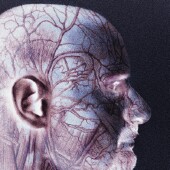 |
 |
 |

3-D MRI Helps Detect Patients at High Risk for Stroke
Technique accurately found bleeding within walls of diseased carotid arteries|
|
HealthDay
By Kevin McKeever
Tuesday, September 16, 2008
 TUESDAY, Sept. 16 (HealthDay News) -- Canadian researchers say that three-dimensional MRI may prove to be a useful screening tool for patients at high risk for stroke, a new report suggests.
TUESDAY, Sept. 16 (HealthDay News) -- Canadian researchers say that three-dimensional MRI may prove to be a useful screening tool for patients at high risk for stroke, a new report suggests.
In a study, published in the October issue of Radiology, researchers at Sunnybrook Health Sciences Centre in Toronto found 3-D MRI accurately detected bleeding within the walls of diseased carotid arteries.
When major arteries are affected by atherosclerosis, fatty deposits -- or plaques -- accumulate on the inner lining of the vessel walls. Over time, this causes narrowing and restricts blood flow or completely blocks the arteries.
New studies point to the composition of complicated plaques as a leading cause of vascular issues and death. Previous, they believed that this narrowing, called stenosis, was responsible for most heart attacks or strokes.
"There's been a major sea change in our research," Dr. Alan R. Moody, of the University of Toronto, said in a news release issued by the journal's publisher. "We now know that the composition of carotid artery plaque is likely to be more predictive of future stroke events than the amount of stenosis in the vessel."
In the study, the research team found matches between the lesions identified by the MRI as complicated plaques in 11 patients and the analysis under a microscope of the samples removed from these patients' diseased arteries.
"With high spatial resolution 3-D MRI, we are able to noninvasively analyze the tissue within the artery wall and identify small bleeds within rupture-prone plaques that may put patients at risk for future stroke," Moody said.
The MRI tool would be ideal to screen high-risk patients for complicated carotid plaques and to monitor the effects of other treatments to slow the disease's progression, Moody said, adding that the technique is quick and easy to perform and interpret, he said.
HealthDay
Copyright (c) 2008 ScoutNews, LLC. All rights reserved.
Related News:
More News on this Date
Related MedlinePlus Pages:
| Home | Health Topics | Drugs & Supplements | Encyclopedia | Dictionary | News | Directories | Other Resources | |
| Disclaimers | Copyright | Privacy | Accessibility | Quality Guidelines U.S. National Library of Medicine, 8600 Rockville Pike, Bethesda, MD 20894 National Institutes of Health | Department of Health & Human Services |
Date last updated: 17 September 2008 |




